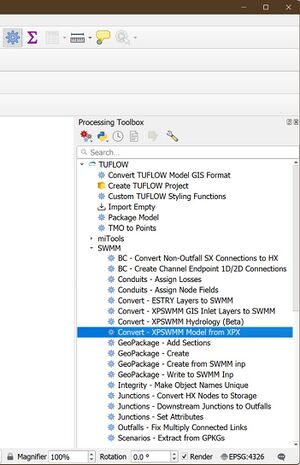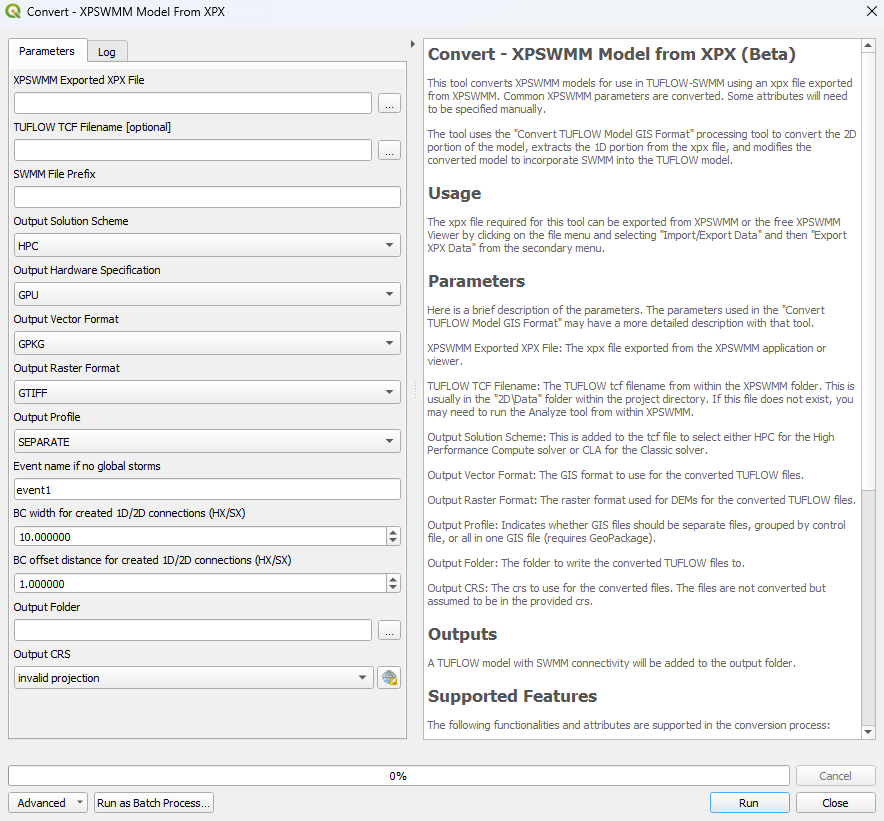QGIS SWMM Convert XPSWMM Model From XPX: Difference between revisions
Created page with "== Introduction == This tool converts XPSWMM Hydrology data for use in TUFLOW-SWMM. Unfortunately, XPSWMM does not write out all required hydrology information when doing a si..." |
No edit summary |
||
| (8 intermediate revisions by 2 users not shown) | |||
| Line 1: | Line 1: | ||
== Introduction == |
== Introduction == |
||
This tool converts XPSWMM models for use in TUFLOW-SWMM using a xpx file exported from XPSWMM. Common XPSWMM parameters are converted. Some attributes will need to be specified manually. |
|||
This tool converts XPSWMM Hydrology data for use in TUFLOW-SWMM. Unfortunately, XPSWMM does not write out all required hydrology information when doing a simple export to EPA SWMM 5. Some of the parameters, especially infiltration parameters (such as curve numbers), do not get written correctly. This tool can extract information from GIS data exported from XPSWMM for nodes and subcatchments, manipulate it, and add it to the exported EPA SWMM 5 file data. |
|||
The tool uses the <u>[[Convert_TUFLOW_Model_GIS_Format |Convert TUFLOW Model GIS Format]]</u> processing tool to convert the 2D portion of the model, extracts the 1D portion from the xpx file, and modifies the converted model to incorporate SWMM into the TUFLOW model. |
|||
'''Please refer to <u>[[XPSWMM_to_TUFLOW-SWMM |XPSWMM to TUFLOW SWMM]]</u>, for further instructions on the model conversion process. ''' |
|||
| ⚫ | |||
| ⚫ | |||
<ol> |
<ol> |
||
<li>From the top dropdown menu options, select File > Import/Export Data > Export XPX Data. This will open a dialog. Leave all options as default and click 'Export'. |
|||
<li>Ensure 'Runoff Mode' is selected. |
|||
<li>When prompted, save the file under an appropriate name to the folder where the XPSWMM model is located. |
|||
<li>From the top dropdown menu options, select File > Import/Export Data > Export to EPASWMM 5. This will create a '.inp' file in the folder with the XPSWMM project file. To prevent it from being overwritten, it is recommended to copy this file to a new name. |
|||
</ol> |
|||
To export the GIS Subcatchment data (required to align with the hydrology data associated with nodes): |
|||
| ⚫ | |||
<li>Right click on the catchments layer (under the nodes layer) and click 'Export to GIS File'. Ensure 'All Objects' is ticked on, then click 'Export'. |
|||
<li> Choose an appropriate filename to write the information to. |
|||
</ol> |
|||
To export the Hydrology data associated with the nodes: |
|||
<ol> |
|||
<li>Right click on the nodes layer and choose 'Export to GIS File'. |
|||
<li>Expand the 'Node Data and Results' and then the 'Runoff Node' folder. |
|||
<li>The columns to include vary based on the hydrology and infiltration options being used by XPSWMM and what will be used in the TUFLOW-SWMM model. Find the appropriate data fields and double click to add them to the list. |
|||
<li>Choose an appropriate filename to write the information to. Ensure the export file format is '.mif', then click 'Export'. |
|||
</ol> |
</ol> |
||
'''Note:''' The xpx file can be exported from XPSWMM or the free XPSWMM Viewer. |
|||
<br> |
<br> |
||
== Usage == |
== Usage == |
||
This tool, '''Convert - XPSWMM |
This tool, '''Convert - XPSWMM model from XPX''', can be found in the QGIS processing toolbox panel under TUFLOW >> SWMM. To open the Processing Toolbox panel, navigate to 'Processing' in the menu bar and select 'Toolbox'.<br> |
||
| ⚫ | |||
<br> |
|||
| ⚫ | |||
This opens the Processing Toolbox panel, where the tool '''Convert - XPSWMM Model from XPX''' can be found under the group TUFLOW >> SWMM. |
|||
[[File:XPSWMM model from XPX.jpg|frameless]] |
|||
<br> |
<br> |
||
=== Parameters === |
=== Parameters === |
||
<ol> |
<ol> |
||
<li>'''XPSWMM Exported XPX File:''' The *.xpx file exported from the XPSWMM application or viewer. |
|||
<li>'''Input SWMM subcatchment layers (named Hydrology--Subcatchments):''' |
|||
<li>'''TUFLOW TCF Filename:''' The TUFLOW control file (TCF) from the XPSWMM model. By default, this will be located in the '''2D\Data''' folder. |
|||
<li>'''Input GIS Subcatchments (exported via XPSWMM right-click on subcatchments):''' XPSWMM GIS layer containing the subcatchment data. |
|||
<li>'''SWMM File Prefix:''' Sets the prefix for the SWMM files in the converted model. |
|||
<li>'''Input GIS Nodes (exported via XPSWMM right-click on nodes):''' XPSWMM GIS layer containing the hydrology data associated with the nodes. |
|||
<li>'''Output Solution Scheme:''' The solution scheme for the converted model. |
|||
<li>'''Output Subcatchments Layer:''' Determines the location and filename of the output GIS layer. This layer will contain the required fields for the 'Hydrology--Subcatchments' layer of a TUFLOW-SWMM GeoPackage. |
|||
<li>'''Output Hardware Specification:''' The hardware selection for the converted model |
|||
<li>'''Output Vector Format:''' The GIS format to use for the converted TUFLOW files. |
|||
<li>'''Output Raster Format:''' The raster format used for the DEMs in the converted model. |
|||
<li>'''Output Profile:''' The format of the output TUFLOW GIS files. |
|||
<li>'''Event name if no global storms:''' Event name for converted TUFLOW files. |
|||
<li>'''BC width for created 1D/2D connections (HX/SX):''' Width of 1D/2D connections. This value should be approximately 2 times the width of the hydraulic model 2D cell size. |
|||
<li>'''BC offset distance for created 1D/2D connections (HX/SX):''' Distance from the channel endpoint to the midpoint of the BC line. |
|||
<li>'''Output Folder:''' Determines the location of the converted model. To ensure correct TUFLOW-SWMM model folder structure, navigate to an appropriate file location, create a '''TUFLOW''' folder and select it. |
|||
<li>'''Output CRS:''' The CRS (Coordinate Reference System) for the TUFLOW-SWMM model. The tool will apply this CRS to the output files.. |
|||
</ol> |
</ol> |
||
<br> |
<br> |
||
[[File: |
[[File: Convert_XPSWMM_Model_From_XPX_Dialog.png]] |
||
| ⚫ | |||
== Example == |
|||
<br> |
|||
{{Video|name=.mp4|width=1236}} |
|||
<br> |
|||
{{Tips Navigation |
{{Tips Navigation |
||
Latest revision as of 15:34, 21 January 2025
Introduction
This tool converts XPSWMM models for use in TUFLOW-SWMM using a xpx file exported from XPSWMM. Common XPSWMM parameters are converted. Some attributes will need to be specified manually. The tool uses the Convert TUFLOW Model GIS Format processing tool to convert the 2D portion of the model, extracts the 1D portion from the xpx file, and modifies the converted model to incorporate SWMM into the TUFLOW model.
Please refer to XPSWMM to TUFLOW SWMM, for further instructions on the model conversion process.
To export the xpx file from XPSWMM:
- From the top dropdown menu options, select File > Import/Export Data > Export XPX Data. This will open a dialog. Leave all options as default and click 'Export'.
- When prompted, save the file under an appropriate name to the folder where the XPSWMM model is located.
Note: The xpx file can be exported from XPSWMM or the free XPSWMM Viewer.
Usage
This tool, Convert - XPSWMM model from XPX, can be found in the QGIS processing toolbox panel under TUFLOW >> SWMM. To open the Processing Toolbox panel, navigate to 'Processing' in the menu bar and select 'Toolbox'.

This opens the Processing Toolbox panel, where the tool Convert - XPSWMM Model from XPX can be found under the group TUFLOW >> SWMM.
Parameters
- XPSWMM Exported XPX File: The *.xpx file exported from the XPSWMM application or viewer.
- TUFLOW TCF Filename: The TUFLOW control file (TCF) from the XPSWMM model. By default, this will be located in the 2D\Data folder.
- SWMM File Prefix: Sets the prefix for the SWMM files in the converted model.
- Output Solution Scheme: The solution scheme for the converted model.
- Output Hardware Specification: The hardware selection for the converted model
- Output Vector Format: The GIS format to use for the converted TUFLOW files.
- Output Raster Format: The raster format used for the DEMs in the converted model.
- Output Profile: The format of the output TUFLOW GIS files.
- Event name if no global storms: Event name for converted TUFLOW files.
- BC width for created 1D/2D connections (HX/SX): Width of 1D/2D connections. This value should be approximately 2 times the width of the hydraulic model 2D cell size.
- BC offset distance for created 1D/2D connections (HX/SX): Distance from the channel endpoint to the midpoint of the BC line.
- Output Folder: Determines the location of the converted model. To ensure correct TUFLOW-SWMM model folder structure, navigate to an appropriate file location, create a TUFLOW folder and select it.
- Output CRS: The CRS (Coordinate Reference System) for the TUFLOW-SWMM model. The tool will apply this CRS to the output files..
| Up |
|---|

